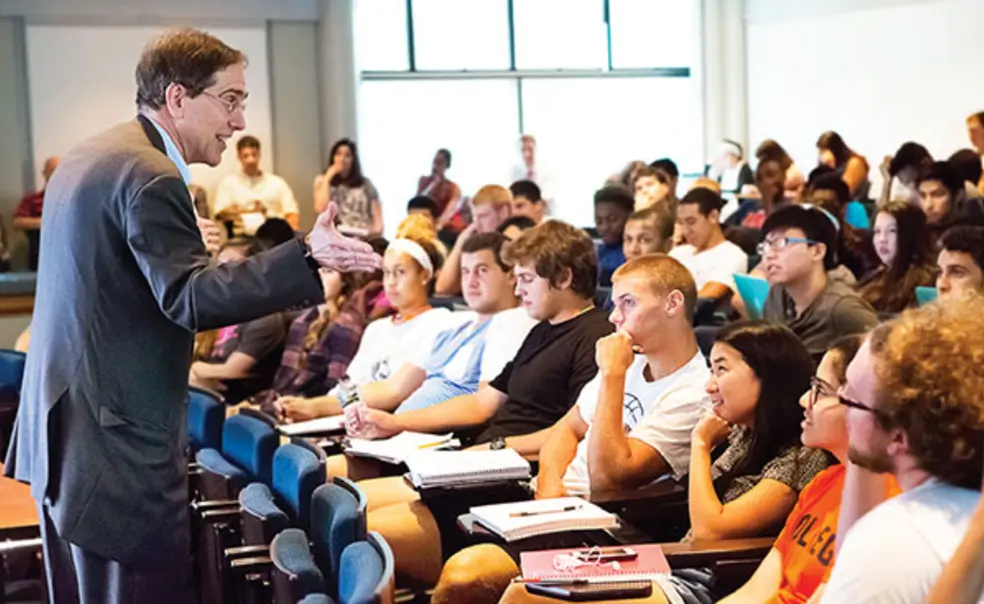Increasing Access Across the Country
This February, I attended the second Presidential Summit of the American Talent Initiative (ATI), a national effort to expand college access and opportunity for talented low- and moderate-income students. ATI aims to attract, enroll, and graduate an additional 50,000 lower-income students by 2025.
Recognizing that no institution can accomplish this goal alone, ATI intends to engage as many members as possible among the 290 U.S. colleges and universities that consistently graduate at least 70 percent of their students within six years. ATI focuses on colleges with high graduation rates because the degree is the difference maker: students who obtain degrees get better jobs and have more opportunities. Institutions with strong graduation rates give high-achieving, low-income students the best shot at success and social mobility.
By forming a coalition, ATI hopes to increase accountability, exchange best practices, and generate momentum to make college access a presidential priority at colleges and universities nationwide. The ATI model recognizes that different institutions will make progress in different ways, ways that may include improving recruitment, strengthening financial aid, or eliminating gaps in graduation rates.
Princeton’s efforts to increase socioeconomic diversity and enable students from all backgrounds to thrive on our campus address four key steps along the pathway to, through, and beyond the University. First, we have improved outreach to prospective low-income students. For example, we now tailor our mailings and materials to appeal more effectively to low-income students. We have also expanded our support for pre-matriculation programs such as Leadership Enterprise for a Diverse America (LEDA), the Princeton University Preparatory Program, and the Princeton Summer Journalism Program. These programs help prepare talented, low- income high school students to pursue a college education at outstanding schools across the country. Many of our peers rely on these programs sited at Princeton as a pipeline of talent.
Second, the Office of Admission has strengthened its ability to identify talented scholars from all backgrounds who will succeed at Princeton once they apply. These efforts have benefited from expanded partnerships with national programs, such as QuestBridge, that help to match students from low- income families with colleges where they can flourish.
Third, we have looked for ways to yield more of the low- income students whom we admit. For example, we defray the expenses of students who could otherwise not afford to participate in Princeton Preview, our program for admitted students. When admitted students visit campus, we can do a better job communicating to them about the education we offer, the communities that would embrace them, and the financial support we provide—including the no-loan, all-grant financial aid program that makes us one of the most affordable colleges in the world.
These efforts have made a dramatic difference. Over the last decade, we have nearly doubled the number of students in the entering class who are Pell-grant recipients or first- generation college students. Taken together, these students make up 29 percent of this year’s freshman class. Expanding the undergraduate student body by 125 students per class will increase our capacity to build on this progress.
Finally, we have taken meaningful steps to enhance the resources that support student success. The Freshman Scholars Institute (FSI) is a seven-week summer program for talented incoming first-year students who have not had access to the same kinds of opportunities that others have enjoyed. It provides an on-ramp to Princeton’s intellectual culture through seminars, labs, and co-curricular experiences. The Scholars Institute Fellows Program (SIFP) complements FSI by offering low-income and first-generation students mentorship, leadership opportunities, and scholarly community throughout their time at Princeton.
The quality of these initiatives has attracted national attention in The New York Times, The Washington Post, and The Chronicle of Higher Education. Associate Dean of the College Khristina Gonzalez and Nimisha Barton, the associate director of FSI and programs for access and inclusion, were recently featured in—of all places—Harvard Magazine, which told Harvard alumni that “Princeton, of late, has focused its energy and resources on an unequaled scale, bringing every element of programs for first-generation and low-income students’ success into an integrated whole, with thoughtful preparation for their academic, co-curricular, and social lives on campus.”
As we look toward the future, we seek both to continue our progress on Princeton’s campus and to collaborate with other institutions leading the effort to increase college access and social mobility. That is why Princeton was among the 30 founding members of ATI, and why I’m proud to be one of the five college presidents serving on its steering committee.
When I speak about this topic around the country, I find it especially meaningful to share the stories of excellence and resilience exemplified by our low-income and first-generation students. Unleashing their talents through access to a transformative college education benefits not only Princeton, but the future of our country and the world.











2 Responses
Chin-Kuan Tung *08
7 Years AgoAnother Pipeline Issue
I applaud Princeton’s dedication to increasing the enrollment of low-income and first-generation college students (President’s Page, March 21). I am writing to draw attention to a different perspective of the issue. I teach at North Carolina Agricultural and Technical State University, a public historically black university (HBCU). Low-income and first-generation students probably make up the majority of our student body.
When the top-end higher-education institutions expand their pipeline of recruitment, we lose our best students, and the future students on our campus lose the examples that they can look up to. Ideally, we will put in the same efforts to expand the pipeline of our recruitment to make more students ready for college education.
Unfortunately, we do not have the same level of resources that Princeton enjoys. It is difficult for us to create the comprehensive programs that mirror what Princeton put in place, and it can be argued that the programs needed for our goal may require a larger-scale effort. By no means am I trying to suggest Princeton do anything differently in increasing the diversity of the student body. The point here is to draw some attention to the systemic problem that cannot be solved by aggressive recruitment without fundamental improvement of the K-12 pipeline.
I do not pretend to know what is needed, but I suspect that we need to create an environment for something more dramatic to happen to the education system.
Tony Rodríguez ’79
7 Years AgoIncreased Access Benefits All Students
As a first-generation college graduate, I have enjoyed volunteering with the University’s efforts to support first-generation and low-income students. Our work has connected these talented low-income and first-generation students to all kinds of alumni who are interested in mentoring and helping students find internships and permanent jobs. So you can imagine how pleased I was to read President Eisgruber’s Page dealing with “Increasing Access.”
I am very proud of my alma mater playing a leadership role in boosting access and diversity for our country’s higher education. Thank you, Chris, for your foresight and iniatives to ensure these students thrive at Princeton and beyond. And I encourage alumni of all stripes to connect with Princeton students as a very rewarding way to “give back.”